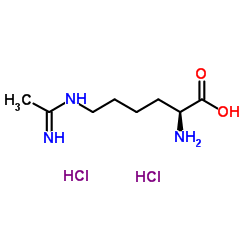L-NIL dihydrochloride

L-NIL dihydrochloride structure
|
Common Name | L-NIL dihydrochloride | ||
|---|---|---|---|---|
| CAS Number | 159190-45-1 | Molecular Weight | 260.161 | |
| Density | N/A | Boiling Point | 369ºC at 760 mmHg | |
| Molecular Formula | C8H19Cl2N3O2 | Melting Point | N/A | |
| MSDS | Chinese USA | Flash Point | 177ºC | |
| Symbol |

GHS07 |
Signal Word | Warning | |
Use of L-NIL dihydrochlorideL-NIL dihydrochloride is an inducible NO synthase inhibitor, with an IC50 of 3.3 μM for miNOS[1][2][3]. |
| Name | L-N6-(1-Iminoethyl)lysine dihydrochloride |
|---|---|
| Synonym | More Synonyms |
| Description | L-NIL dihydrochloride is an inducible NO synthase inhibitor, with an IC50 of 3.3 μM for miNOS[1][2][3]. |
|---|---|
| Related Catalog | |
| Target |
IC50: 3.3 μM (mouse inducible NO synthase), 92 μM (rat brain constitutive NO synthase)[3]. |
| In Vitro | L-NIL produces a concentration-dependent inhibition of both the mouse inducible NOS (miNOS) and the rat brain constitutive NOS (rcNOS) and is considerably more potent for miNOS. The IC50 values for L-NIL with miNOS and rcNOS are 3.3 and 92 pM, respectively, indicating that L-NIL is 28-fold more selective for miNOS. In addition, L-NIL has approximately 6-fold greater potency for miNOS than either L-NMA or L-NNA[2]. |
| In Vivo | L-NIL (10 and 30 mg/kg, IP) prevents the inflammation, oxidative stress and autophagy induced by renal IR in mice[1]. Animal Model: Adult male Balb/c (20-25 g)[1]. Dosage: 10 and 30 mg/kg. Administration: Intraperitoneally at the end of CLP and at 6 h after sepsis induction. Result: Led to a negligible increase in plasma NGAL compared to sham mice. Led to a significant decrease in both TLR4 and IL1βprotein contents and clusterin transcript. Showed an increase in NFAT5 mRNA levels, as compared with mice treated with vehicle. Promoted a decrease in AR protein expression, as compared with animals treated with vehicle. |
| References |
| Boiling Point | 369ºC at 760 mmHg |
|---|---|
| Molecular Formula | C8H19Cl2N3O2 |
| Molecular Weight | 260.161 |
| Flash Point | 177ºC |
| Exact Mass | 259.085419 |
| PSA | 99.20000 |
| LogP | 2.95030 |
| InChIKey | OQIBCXRAFAHXMM-UHFFFAOYSA-N |
| SMILES | CC(N)=NCCCCC(N)C(=O)O.Cl.Cl |
| Storage condition | 20°C |
| Symbol |

GHS07 |
|---|---|
| Signal Word | Warning |
| Hazard Statements | H315-H319-H335 |
| Precautionary Statements | P261-P305 + P351 + P338 |
| Personal Protective Equipment | dust mask type N95 (US);Eyeshields;Gloves |
| Hazard Codes | Xi: Irritant; |
| Risk Phrases | R36/37/38 |
| Safety Phrases | S37/39 |
| RIDADR | NONH for all modes of transport |
|
Effects of nitric oxide synthase deficiency on a disintegrin and metalloproteinase domain-containing protein 12 expression in mouse brain samples.
Mol. Med. Report. 12 , 2253-62, (2015) A disintegrin and metalloproteinase domain-containing protein 12 (ADAM12) belongs to the ADAM family of transmembrane proteins. Via proteolysis, cell adhesion, cell-cell fusion, cell-matrix interactio... |
|
|
Leptin administration activates irisin-induced myogenesis via nitric oxide-dependent mechanisms, but reduces its effect on subcutaneous fat browning in mice.
Int. J. Obes. 39(3) , 397-407, (2015) BACKGROUND/OBJETIVES: Obese leptin-deficient ob/ob mice exhibit high adiposity and reduced muscle mass with leptin replacement promoting weight loss and inducing muscle accretion through PGC-1α-depend... |
|
|
L-N6-(1-iminoethyl)lysine: a selective inhibitor of inducible nitric oxide synthase.
J. Med. Chem. 37 , 3886, (1994) L-N6-(1-Iminoethyl)lysine (L-NIL) has been synthesized and is shown to be both a potent and selective inhibitor of mouse inducible nitric oxide synthase (miNOS). L-NIL has an IC50 of 3.3 microM for mi... |
| N(6)-acetimidoyl-L-lysine dihydrochloride |
| N-Ethanimidoyl-L-lysine dihydrochloride |
| l-n6-(1-iminoethyl)lysine dihydrochloride |
| L-Lysine, N-(1-iminoethyl)-, hydrochloride (1:2) |